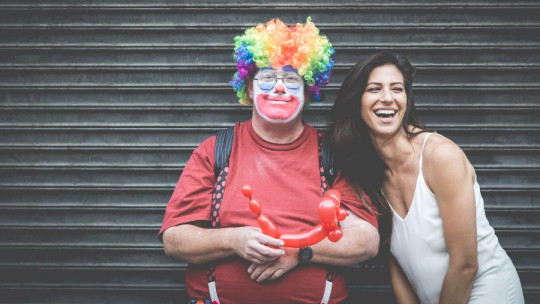
For a long time, the focus has been on why we are sad or why we suffer from a disorder, with the clear intention of “correcting” the problem.
However, What many psychologists and psychiatrists had forgotten is understanding why we laugh to encourage laughter and promote long-term psychological well-being.
Although research has been expanding this issue a little more in recent years, the truth is that this question still raises many unknowns. Let’s look at this issue a little more in depth.
Why do human beings laugh?
Throughout the history of psychology, much attention has been paid to negative and pathological aspects rather than positive ones when trying to understand how they originate. Whether it is anxiety, stress, depression or anger, these emotions have been widely studied, with the intention of finding out how to correct them. On the other hand, positive emotions have been viewed only as the desired result, without understanding why they occur.
Fortunately, the vision has been changing. Currently it is about understanding the origin of the person’s discomfort, making them relate in a healthier way and achieving well-being, but understanding how to produce that positive situation and maintain it. This idea has been highly defended in currents such as positive psychology, led by Martin Seligman, promoting acceptance and understanding of positive emotions without pathologizing negative emotions or treating them as terribly undesirable.
Laughing is undoubtedly good, having multiple benefits at an organic level. It has been linked not only to having greater physical and emotional well-being, but also to acquires a very important role at an evolutionary level, demonstrated in our social relationships. Despite all this, it has not been until a long time ago that attempts have been made to approach laughter scientifically, with the intention of answering the question of why we laugh. That question is so simple and, at the same time, so complex, that its answer still remains, broadly speaking, a mystery.
The importance of laughing
Happiness, joy, humor and laughter are positive phenomena necessary for our body. In most cases, and as long as they occur in the appropriate contexts, these emotions have a clear adaptive function, on a personal and social level. Usually, When we laugh with other people we are acting in a clearly prosocial way giving them signs that we enjoy being with them, something that enhances relational ties.
Laughter is a very important non-verbal component when it comes to communicating. It is the non-explicit way of indicating that what we are saying is either a joke or something that should be interpreted with humor. For example, if we say something that appears to be serious but, at the same time, we laugh, it is as if we were making light of the matter. It softens the blow and prevents you from having an awkward moment with other people, preserving relationships.
And this is where it acquires its evolutionary importance. Laughter is a phenomenon that has been observed in other species, many of them close to humans (bonobos, chimpanzees, gorillas and orangutans) and has also been seen in foxes. Laughter in the animal world serves to indicate that, when a certain action is being carried out, it is not serious, for example in “fights” or biting between foxes. It’s their way of saying that “they’re just playing, there’s nothing to worry about.”.
Another important aspect of laughter is its regulatory function of group behavior, attributed to the fact that it can be spread. As with yawning and posture, laughter is contagious, causing the members of a group to synchronize by laughing all at the same time, even if they have no clear reason for doing so.
The reason why laughter is contagious has to do with some very important neurons for human beings: mirror neurons. These neurons are of great importance in our behavior, since they are what allow us to replicate the gestures of others. The same thing would happen with laughter: when we see another person laugh, these neurons would be activated and we would replicate their behavior.
What benefits does laughter have?
Laughter has a very positive influence on an organic level. Stimulates the immune system, which translates into greater resistance against pathogens. It has also been observed that thanks to it our pain threshold increases, that is, it makes us less sensitive to pain. It is for this reason that therapies such as laughter therapy have proven useful in hospital settings and various medical treatments. Although the disease is not cured, the person who suffers from chronic pain does not feel it as much.
It has been observed that laughing contributes to a reduction in cholesterol levels and an improvement in blood oxygenation. You shouldn’t think that laughing is synonymous with running a marathon, but it does turn out to be a good aerobic exercise. Thanks to its effects, it has been possible to relate being a smiling person to having up to 40% fewer vascular problems, making you live on average four and a half years longer. That is, you could say that the popular saying “laughing lengthens life.”
But, in addition to the physical, it is obvious that laughter influences our mental health. The act of laughing helps calm anger, which, in addition to reducing the risk of heart problems, prevents relationship problems. In addition, it contributes to raising the mood, increasing the levels of dopamine and endorphins, hormones involved in psychological well-being.
What happens in our brain when we laugh?
Thanks to modern neuroimaging techniques, it has been possible to see how the brain behaves when we laugh.
First, for laughter to occur, it is necessary for our brain to interpret a stimulus received as something incongruent. That is, when we interact with the world, our brain expects things to happen according to its rational predictions. If something deviates from that reasoning, the brain interprets it as an inconsistency, which surprises it.
This is easy to understand when they tell us a joke. We find it funny because the “punchline” surprised us. This perception of surprising incongruity would occur in the dorsolateral prefrontal region and temporoparietal junction of the dominant hemisphere.
Subsequently, and in response to this incongruity, the brain activates the reward circuit. It does this by releasing dopamine, which is the neurotransmitter that produces that pleasant feeling associated with laughter and happiness. It is for this reason that it can be said that laughter is very closely related to other pleasurable phenomena, in which the reward circuit is also activated, such as drug use, sex, being in a social relationship or eating. .
The phenomenon of humor
In our species, laughter is innate, beginning to manifest after the first five weeks of life. The fact that laughter is something universal can be verified with deaf, blind or deafblind people. In these three groups, as long as there is no comorbid disorder associated with relational problems, laughter is a phenomenon that occurs naturally, even if they have never seen and/or heard it.
Anything, no matter how simple and banal, can make us laugh. However, laughter should not be confused with humor, a component that, although closely related to it, is not universal. Humor depends on cultural, personality and development factors, causing each person to have a very different sense of what makes them laugh.
This is why some people are more serious than others, since their idea of what is funny may be much stricter than ours. Factors such as age and sex also influence. Women laugh more, enjoying humor more, since it has been seen that two specific areas of the brain related to the brain are activated in them: language and short-term memory.
It has also been seen that we do not all laugh in the same way. Psychologist Paul Ekman, a pioneer in the study of emotions, was able to differentiate up to 16 different types of smiles and laughter, each with a different emotional meaning and interpretation. In addition, there has been research into how true or false laughter is, with Guillaume Duchenne as a pioneer in these studies, who observed that the way the eyes squint in fake laughter is very different from how it is done in the truly.
Pathological laughter syndrome
In the same way that laughter can be synonymous with happiness and imply multiple benefits at an organic level, it can also be indicative that one is suffering from a serious problem. There are laughs that are caused by stress, anxiety, tension or as a result of a neurological injury.
Laughter that is dysfunctional, manifesting itself in an uncontrolled manner and with excessive intensity, is what is known as pathological laughter syndrome, which can also transform into crying and quickly alternate between euphoria and sadness.
This syndrome can be observed in multiple medical and psychiatric conditions, such as schizophrenia, various types of dementia, Angelman syndrome, epilepsy, stroke, multiple sclerosis, amyotrophic lateral sclerosis (ALS), Parkinson’s disease or brain tumors. In these cases, laughter is an indicator that one is suffering from a health problem and requires medical, surgical, psychiatric and psychological intervention.








